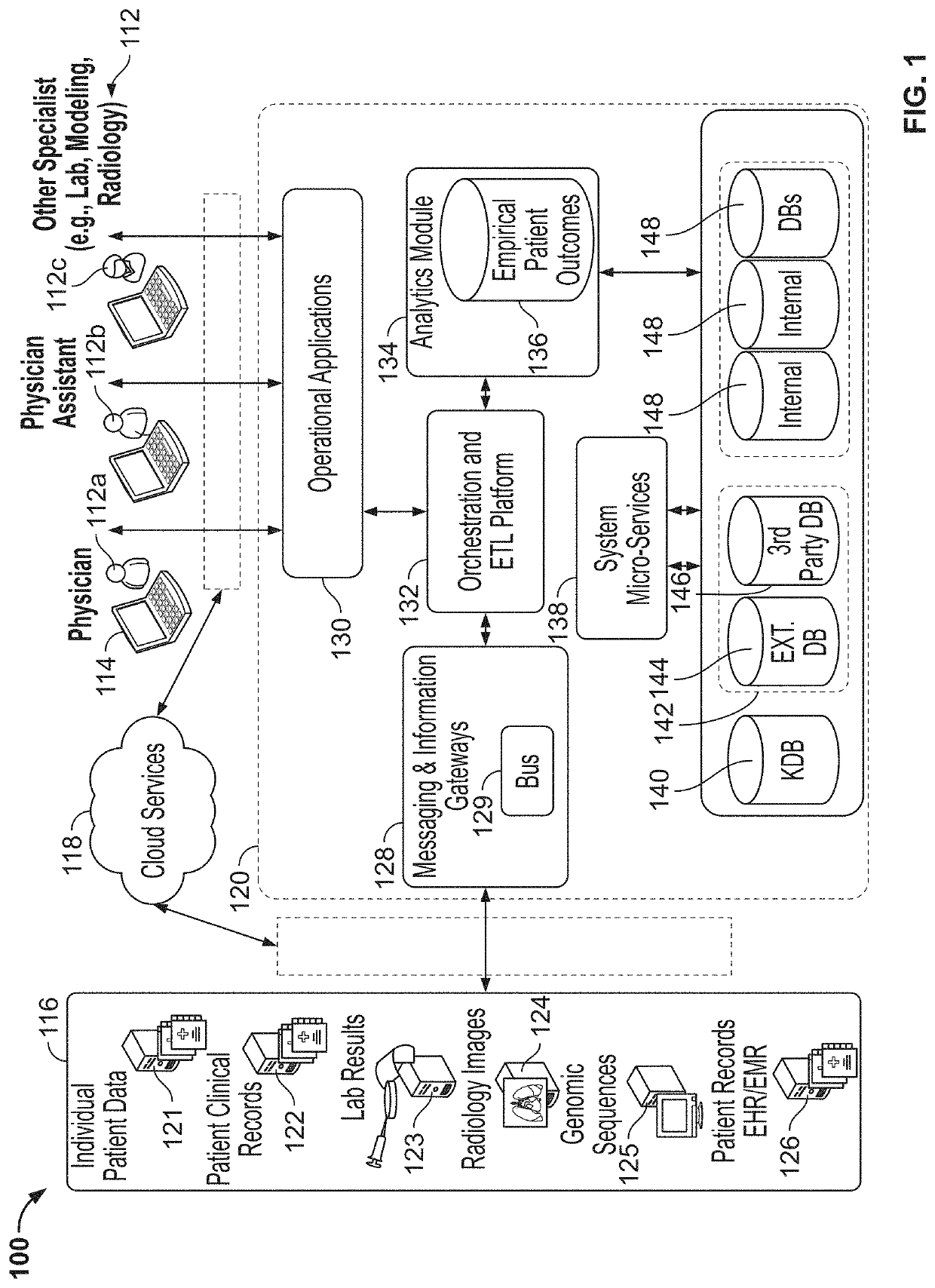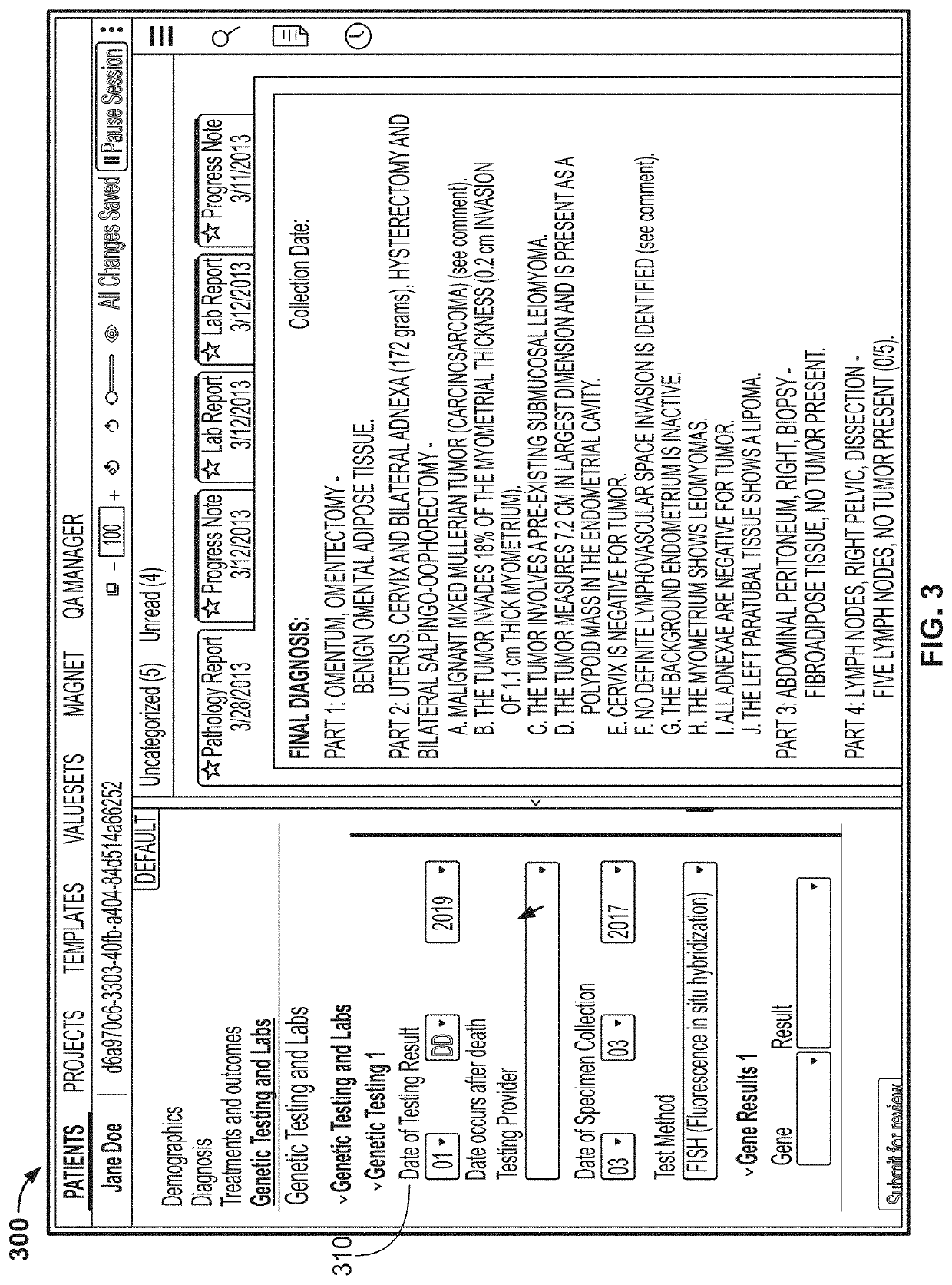One problem with
genetic testing is that the testing is expensive and can be cost prohibitive in many cases—oftentimes, insurance companies refuse to cover the cost.
In other words, in most cases, how genetic test results can be used to prescribe better treatment plans for patients is not fully known, so the extra expense associated with genetic testing in specific cases cannot be justified.
Thus, while promising, genetic testing as part of treatment planning has been minimal or sporadic at best.
In most cases, patient treatments and results are not published for general consumption and therefore are simply not accessible to be combined with other treatment and results data to provide a more fulsome overall
data set.
In this regard, many physicians see
treatment results that are within an expected range of
efficacy and may conclude that those results cannot add to the overall treatment
knowledge base; those results often are not published.
The problem here is that the expected range of
efficacy can be large (such as 20% of patients experience a significant reduction in symptoms, 40% of patients experience a moderate reduction in symptoms, 20% experience a mild reduction in symptoms, and 20% do not respond to a
treatment plan) so that all
treatment results are within an expected
efficacy range and treatment result nuances are simply lost.
Additionally, there is no easy way to build on and supplement many existing illness-treatment-results databases.
As such, as more data is generated, the new data and associated results cannot be added to existing databases as evidence of
treatment efficacy or to challenge efficacy.
Thus, for example, if a researcher publishes a study in a medical journal, there is no easy way for other physicians or researchers to supplement the data captured in the study.
Without data supplementation over time, treatment and results corollaries cannot be tested and confirmed or challenged.
Thousands of articles relevant to diseases are published each year and many are verbose and / or intellectually thick so that the articles are difficult to read and internalize, especially by extremely busy physicians that have limited time to absorb
new materials and information.
Distilling publications down to those that are pertinent to a specific physician's practice takes time and is an inexact endeavor in many cases.
To this end, prescribing and treating physicians know what they know and painstakingly capturing a complete set of
disease state, treatment and results data without getting something in return (such as a new insight, a better prescriptive treatment tool, etc.) may be perceived as burdensome to the physician.
In addition to problems associated with collecting and memorializing treatment and results data sets, there are problems with digesting or consuming recorded data to generate useful conclusions.
For instance, recorded
disease state, treatment and results data is often incomplete.
In most cases physicians are not researchers and they do not follow clearly defined research techniques that enforce tracking of all aspects of disease states, treatments and results.
As a result, data that is recorded is often missing key information such as, for instance, specific patient conditions that may be of current or future interest, reasons why a specific treatment was selected and other treatments were rejected, specific results, etc.
In many cases where cause and effect relationships exist between disease state factors and
treatment results, if a physician fails to identify and
record a causal factor, the results cannot be tied to existing cause and effect data sets and therefore simply cannot be consumed and added to the overall disease knowledge
data set in a meaningful way.
Another impediment to digesting collected data is that physicians often capture disease state, treatment and results data in forms that make it difficult if not impossible to process the collected information so that the data can be normalized and used with other data from similar patient treatments to identify more nuanced insights and to draw more robust conclusions.
Using
software to glean accurate information from hand written notes is difficult at best and the task is exacerbated when hand written records include personal abbreviations and shorthand representations of information that
software simply cannot identify with the physician's intended meaning.
Each patient is different, and their different needs and conditions can present a challenge to health systems that must grapple with providing the right resources to their clinicians, at the right time, for the right patients.
However, many electronic health records do not include robust structured data fields that permit storage of clinical data in a structured format.
The remainder of a patient's
record remains isolated, unstructured and inaccessible within text-based or other raw documents, which may even be stored in adjacent systems outside of the formal electronic health
record.
Additionally, physicians and other clinicians would be overburdened by having to manually record hundreds of data elements across hundreds of discrete data fields.
As a result, most raw clinical data is not structured in the
medical record.
Hospital systems, therefore, are unable to mine and / or uncover many different types of clinical data in an automated, efficient process.
Like manual structuring, however, many of such efforts remain limited by errors or incomplete information.
Efforts to structure clinical data also may be limited by conflicting information within a
single patient's record or among multiple records within an institution.
Determination of
data quality across various data sources is both a common occurrence and challenge within the healthcare industry.
In the case of disease treatments where disease states, treatments, results and conclusions are extremely complicated and nuanced, physician and researcher interfaces have to present massive amounts of information and show many data corollaries and relationships.
When massive amounts of information are presented via an interface, interfaces often become extremely complex and intimidating, which can result in misunderstanding and underutilization.
A patient without other
effective treatment options can opt to participate in a
clinical trial if the patient's disease state meets trial requirements and if the trial is not yet fully enrolled (such as there is often a limit to the number of patients that can participate in a trial).
Matching a patient disease state to a subset of ongoing trials is complicated and
time consuming.
One other problem with current
disease treatment planning processes is that it is difficult to integrate new pertinent treatment factors, treatment efficacy data and insights into existing planning databases.
In this regard, known treatment planning databases have been developed with a predefined set of factors and insights and changing those databases often requires a substantial effort on the part of a
software engineer to accommodate and integrate the new factors or insights in a meaningful way where those factors and insights are correctly correlated with other known factors and insights.
In some cases the required substantial effort simply means that the new factor or insight will not be captured in the
database or used to affect planning while in other cases the effort means that the new factor or insight is only added to the
system at some
delayed time required to apply the effort.
One other problem with existing
disease treatment efficacy databases and systems is that they are simply incapable of optimally supporting different types of
system users.
Some genetic tests do not have this capability.
The probe sequences on the
biochip each only contain one sequence, and the probes bind specifically to one complementary sequence in the
DNA, meaning that most probes can only detect one type of
mutation or genetic variant.
This also means that a
microarray will not detect a sequence that is not targeted by the probes on the
biochip.
It cannot be used to find new variants.
The fact that a probe only detects one specific
DNA sequence means that the
microarray cannot determine whether two detected variants are in the same
allele unless the loci of the variants are close enough that a
single probe can span both loci.
Because it is difficult to simultaneously achieve optimal binding conditions for all probes on a
microarray (such as the microarrays used in SNP Chips), any
DNA from a sample has the potential to hybridize to probes that are not perfectly complementary to the sample DNA sequence and cause inaccurate test results.
Furthermore, disadvantages of microarrays include the limited number of probes present to target biomarkers due to the surface area of the
biochip, the misclassification of variants that do not bind to probes as a normal
genotype, and the overall misclassification of the
genotype of the patient.
Due to the limited
processing efficiency of SNP chips, conventional microarray approaches are inefficient in detecting biomarkers and their many included variations.
Taqman assays have limitations similar to those of microarrays.
This leads to the same limitations as SNP chips.
Other genetic tests, such as dot blots and southern blots, have similar limitations.
 Login to View More
Login to View More  Login to View More
Login to View More 


